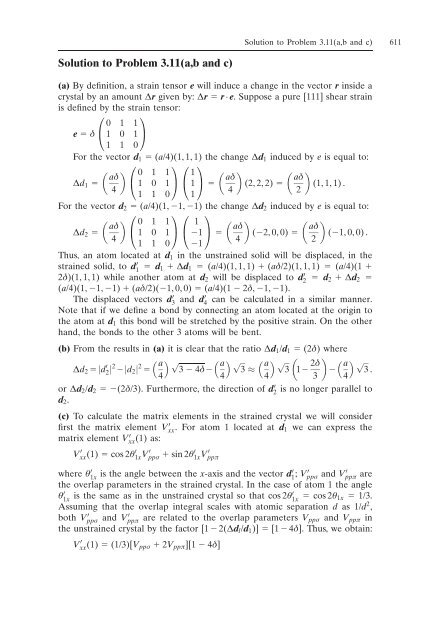10. Appendix
Create successful ePaper yourself
Turn your PDF publications into a flip-book with our unique Google optimized e-Paper software.
Solution to Problem 3.11(a,b and c)<br />
Solution to Problem 3.11(a,b and c) 611<br />
(a) By definition, a strain tensor e will induce a change in the vector r inside a<br />
crystal by an amount ¢r given by: ¢r r · e. Suppose a pure [111] shear strain<br />
is defined by the strain tensor:<br />
⎛ ⎞<br />
0 1 1<br />
e ‰ ⎝ 1 0 1⎠<br />
1 1 0<br />
For the vector d1 (a/4)(1, 1, 1) the change ¢d1 induced by e is equal to:<br />
<br />
a‰<br />
¢d1 <br />
4<br />
⎛ ⎞ ⎛<br />
0 1 1<br />
⎝ 1 0 1⎠⎝<br />
1 1 0<br />
1<br />
⎞<br />
<br />
1 ⎠<br />
a‰<br />
a‰<br />
(2, 2, 2) (1, 1, 1) .<br />
4<br />
2<br />
1<br />
For the vector d2 (a/4)(1, 1, 1) the change ¢d2 induced by e is equal to:<br />
<br />
a‰<br />
¢d2 <br />
4<br />
⎛ ⎞ ⎛<br />
0 1 1<br />
⎝ 1 0 1⎠⎝<br />
1 1 0<br />
1<br />
⎞<br />
<br />
<br />
1 ⎠<br />
a‰<br />
a‰<br />
(2, 0, 0) (1, 0, 0) .<br />
4<br />
2<br />
1<br />
Thus, an atom located at d1 in the unstrained solid will be displaced, in the<br />
strained solid, to d ′ 1 d1 ¢d1 (a/4)(1, 1, 1) (a‰/2)(1, 1, 1) (a/4)(1 <br />
2‰)(1, 1, 1) while another atom at d2 will be displaced to d ′ 2 d2 ¢d2 <br />
(a/4)(1, 1, 1) (a‰/2)(1, 0, 0) (a/4)(1 2‰, 1, 1).<br />
The displaced vectors d ′ 3 and d′ 4 can be calculated in a similar manner.<br />
Note that if we define a bond by connecting an atom located at the origin to<br />
the atom at d1 this bond will be stretched by the positive strain. On the other<br />
hand, the bonds to the other 3 atoms will be bent.<br />
(b) From the results in (a) it is clear that the ratio ¢d1/d1 (2‰) where<br />
¢d2 |d ′ 2| 2 |d2| 2 <br />
a<br />
√ <br />
a<br />
√ <br />
a<br />
<br />
√<br />
3 4‰ 3 ≈ 3 1<br />
4<br />
4 4<br />
2‰<br />
<br />
a<br />
√<br />
3.<br />
3 4<br />
or ¢d2/d2 (2‰/3). Furthermore, the direction of d ′ 2 is no longer parallel to<br />
d2.<br />
(c) To calculate the matrix elements in the strained crystal we will consider<br />
first the matrix element V ′ xx . For atom 1 located at d1 we can express the<br />
matrix element V ′ xx (1) as:<br />
V ′ xx (1) cos 2ı′ 1x V′ ppÛ sin 2ı′ 1x V′ ppapple<br />
where ı ′ 1x is the angle between the x-axis and the vector d′ 1 ; V′ ppÛ and V′ ppapple are<br />
the overlap parameters in the strained crystal. In the case of atom 1 the angle<br />
ı ′ 1x is the same as in the unstrained crystal so that cos 2ı′ 1x cos 2ı1x 1/3.<br />
Assuming that the overlap integral scales with atomic separation d as 1/d 2 ,<br />
both V ′ ppÛ and V′ ppapple are related to the overlap parameters VppÛ and Vppapple in<br />
the unstrained crystal by the factor [1 2(¢dl/d1)] [1 4‰]. Thus, we obtain:<br />
V ′ xx (1) (1/3)[VppÛ 2Vppapple][1 4‰]










